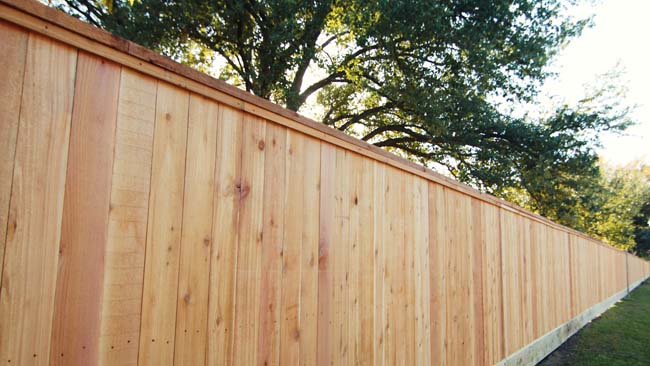DIY Wood Fence Repair: 5 Steps to Get a Fence Looking Good
Are you staring out your window at a tired, beat-up old fence dreaming of the day when it confidently displayed its former glory? Fret no more because we have an easy solution for your wooden woes! A quick DIY wood fence repair. Not only will this rewarding project leave you with a restored fence, but it will also bring back the beauty that once graced your backyard. Let us take you on a walk through 5 simple steps to give your fence the facelift it deserves, adopting the resilient Texas spirit of rolling up your sleeves and getting things done. Now let’s wield those tools and conquer that DIY repair project to make your fence (and neighbors) jealous!

Evaluating Your Fence’s Condition
Before jumping into repairing your wood fence, it’s crucial to evaluate its current condition. Conducting a thorough evaluation can give you an idea of the extent of damage and help you determine whether you need a simple repair or a complete replacement. Here are some factors to consider:
Start by examining the entire length of the fence – look for any damaged or rotten boards, leaning posts, or areas where the fence wobbles. Check if there are any signs of insect infestation, such as termite holes, trails, or sawdust. Scrutinize the area around the base of each post for rotting as well. In case the wood has crumbled into dust or is soft to the touch, then this is a sign that your fence posts are beginning to rot. Be mindful of things like large objects resting against the fence – such pressure can lead to the distortion or collapse of your fence.
It’s important to remember that not all damages are visible at first glance. Therefore, it would be wise to knock on each board gently with a mallet or hammer and listen carefully for any hollow sounds that could indicate decay from within.
Once you have assessed your fences’ general condition and identified potential problem areas, take time next to look closely for specific damage types.
- Before repairing or replacing a wooden fence, it’s crucial to evaluate its current condition thoroughly, examining for visible damage, insect infestation, and any signs of rotting. Knocking on boards with a mallet can help identify any hidden decay. Careful assessment can help determine whether a simple repair or complete replacement is necessary.
Spotting Damage and Deterioration
After initial examination and identification of possible issues in your fence structure, it’s now time to inspect each part more closely to understand which areas require repair work.
Think of checking your fence just like taking your car out on a test drive when you’re planning for an extended road trip – you run through all available checks thoroughly so you’ll know if there are any mechanical issues before setting out miles on end.
Here are some tell-tale signs to look out for when inspecting your fence for damage:
Cracks – The wood fence can develop cracks over time due to weather conditions like wind and rain. These can leave areas exposed and allow water to get in, leading to more serious damage like rot.
Twists or Bends – Fences can often twist or bend when subjected to high winds or heavy objects leaning against it. Misaligned posts or boards are commonly twisted or bent, which could lead to weakness and destabilization of the fencing.
Rotting Wood – Your wooden fence is always susceptible to moisture (wood and water don’t mix); Once wood becomes significantly damp, it’s just a matter of time before it rots. Check for spots where the paint is peeling off from the wood as this could be a possible sign for a much bigger problem.
Insect Damage – Bugs like termites can cause harm to your fence at an alarming rate in a short amount of time. These insects feed on untreated wood during their life cycle and can hollow out up much of your fence if ignored for too long.
Some individuals may argue that there’s no point in repairing old fences and that it would be better to remove them entirely and replace them with new ones. While indeed replacing an old fence may seem like the best course of action, hidden costs such as landscape replacement fees, removal fees, etc., can add up quite quickly. There’s still plenty of cases where DIY wood fence repair won’t suffice; hiring professionals will ensure that you get the job done efficiently while also saving you money down the line.
Understanding what’s wrong with your fence is just half the battle; read on to know how to repair damaged parts properly.
How to Repair Your Wood Fence
DIY wood fence repair can be a daunting task, but with the right knowledge and tools, it can be done without professional help. Here are five steps to repairing your wood fence:
Step 1: Assess the damage
Before beginning repairs, assess the damage by walking around your fence and examining each panel. Look for any cracked or rotten boards, loose nails, or broken posts. If you find extensive damage, you may need to replace the entire panel.
Step 2: Gather necessary tools and materials
Once you have evaluated the damage, gather the necessary tools and materials for the repair. You will need a hammer, screwdriver, drill with drill bits, saw, wood glue or epoxy, screws or nails, replacement boards or posts, level, measuring tape, and safety gear such as gloves and goggles.
Now that you have assessed the damage and gathered the necessary tools and materials let’s move on to the step-by-step guide.
Necessary Tools and Materials
When repairing a wood fence, having the proper tools and materials is essential to making repairs that are safe and long-lasting. Here are some of the necessary tools and materials for repairing your wood fence:
Hammer: A hammer is used to drive nails into wood. It can also be used to remove nails or straighten bent nails.
Drill: A drill with drill bits is used to make pilot holes in wood before inserting screws. It can also be used to remove screws from wood.
Saw: A saw is used to cut replacement boards or posts to size.
Wood glue or epoxy: Wood glue or epoxy is used to reinforce joints or fill gaps in the fence.
Replacement boards or posts: Replacement boards or posts are needed if any parts of the fence need to be replaced.
Screws or nails: Screws or nails are used to attach replacement boards or posts to the fence.
Level: A level is used to ensure that your fence is straight and level.
Measuring tape: A measuring tape is used to measure the length of your replacement boards or posts.
Safety gear: Last but not least, safety gear such as gloves and goggles should always be worn when doing any type of fence repair work.
Now that you know the necessary tools and materials for repairing your wood fence let’s move on to the step-by-step guide.
Step-by-step Repair Guide
Repairing a wood fence may seem like a daunting task, but with the right tools and knowledge, it can be done efficiently and effectively. Here is a step-by-step guide to repairing your wood fence:
1. Assess the Damage: Start by examining your fence for any visible damage or signs of deterioration. Check for rotted or broken boards and posts, loose screws/nails, or warped sections.
2. Gather Necessary Tools and Materials: After identifying the areas that need repair, gather the necessary tools and materials. These may include a hammer, nails/screws, drill, saw, replacement boards/posts/pickets, level tool, wood stain/sealer/protector, sandpaper.
3. Remove Damaged Boards or Posts: Use a pry bar or saw to carefully remove any damaged boards or posts from the fence. If the issue is with a couple of pickets only then it’s best to detour off panel replacements which are easy repairs
4. Replace Them with New Ones: Using appropriate sizes of new wood pieces (if applying) attach using nails or screws in place of the removed ones.
5. Finish the Repair with Stain or Paint: Finally apply a preservative sealant to protect wood from future weathering.
It’s worth mentioning here that if you notice extensive damage involving multiple planks or more than two post(s) then it might be better to hire professionals to manage your fence repairs efficiently.
Hiring Professional Services Vs DIY
While it may be tempting to save money by doing your own fence repair work, there are some advantages to hiring professional fence services:
1. Quality Workmanship: A reputable company like Texas Fence provides skilled workers who have received training in all aspects of fencing installation and repair. They have experience in selecting quality materials to produce high-quality long-lasting work.
2. Faster Work: DIY work requires a significant amount of time and effort that may cause project delays especially when you’re trying to do it alongside other important routines in your life. Hiring professionals ensures that the work gets done quickly and efficiently.
3. Cost Considerations: It’s easy to assume that DIY work is more cost-effective, but many factors contribute to the outcome of selecting either hiring a professional or doing it yourself (i.e., Material cost, Safety costs, Time factor). On balance, it often works out cheaper to hire professionals who have their specific safety materials and professional equipment ready for you.
4. Skill Set: Repairing fences requires specialized skills including familiarity with different types of materials, proper equipment usage, and hands-on practical experiences. Utilizing an experienced company provides added assurance that everything will be handled with the utmost care and professionalism.
For most people owning a home is one of their most sizable investments. It’s therefore recommended to leave any repairs simply beyond your skillset to professionals to avoid causing even more costly damages that may hit hard on your bank account raising the cost down the line.
Thinking of repairing a fence hearkens me back to when as a child given our allowance savings spending hundreds of dollars buying cheap LEGO-branded sets then mindlessly jabbing them together without worrying about how they fit together. Often, one peg wasn’t fully inserted into another leading to loose pieces that fell apart quickly beyond repair after only a few hours spent playing with them. Sadly, this is kind of what happens whenever you try fixing certain problems on your own, especially if they involve extensive damage such as fence repair. When it comes down to serious welding and soldering “DIY” often leads turning trash into treasure ultimately losing value over the long haul and more so expensive repairs going forward.
So why bother hiring a professional service when you can handle fence repair yourself? While DIY repairs can be satisfying to accomplish with your own two hands, there’s also that invisible wall of physical aptitude and knowledge involved. It’s undoubtedly possible for homeowners to perform their own minor maintenance work with success if they apply correct methods of repairs – but an overzealous homeowner too confident in their skills may end up causing more harm than good especially if they lack the necessary knowledge of proper equipment usage and safety precautions.
Cost Considerations
When it comes to DIY wood fence repair, cost is usually one of the main factors people consider. Many homeowners opt for this route because they believe it will save them some money. However, there are several aspects to consider when evaluating the actual cost of repairing your fence on your own.
First, you need to consider the tools and materials required for the job. Even if you have some of the necessary tools at home, you may still need to purchase others. For example, you might need to buy a post-hole digger or a cement mixer if you’re planning to install new posts. Materials expenses can also vary depending on the type of wood used and the extent of the damage.
Secondly, you need to assess whether you have sufficient skills and experience to carry out the repairs yourself. It’s essential to be honest with yourself about this aspect because fence installation is a complex and often time-consuming task. If you’re not sure how to proceed or lack the necessary skills, you might end up doing more harm than good. In that case, hiring professional services might end up being less costly in the long run.
Thirdly, time is a crucial factor in any DIY project. Are you willing to spend several hours or days fixing your fence instead of engaging in other activities? Depending on your schedule and priorities, it might make sense to pay someone else to do the job while you focus on different tasks or interests.
Ultimately, the cost considerations regarding DIY wood fence repair depend on your individual situation and needs. While it might seem like a saving initially, there’s always a risk that unforeseen circumstances or mistakes can add unexpected costs and time expenditures.
A homeowner might think that replacing damaged boards on their old fence would be cheaper than hiring professionals until they get an estimate from a contractor who discovers deeper structural damage inside the posts. Suddenly they realize that they could end up spending far more money than they budgeted for.
Preventing Future Damage to Your Wood Fence
While DIY repairs can help you save some money, it’s important to remember that the best way to keep your fence in good condition is by preventing damage from happening in the first place. Here are some tips on how to do this:
1. Regular Inspection: One of the most effective ways to avoid future damage is by inspecting your fence regularly. Check for signs of wear and tear, rot, insect infestations, or loose boards. Address any problems as soon as you spot them.
2. Trim Vegetation: Trees and shrubs growing too close to your fence can cause damage over time. Branches can scratch or rub against the fence’s surface, and roots can push posts out of alignment or underperform. Keep a distance of at least three feet between your fence and vegetation by trimming trees back regularly.
3. Clean and Stain Your Fence: Regular cleaning and staining can help protect your wooden fence from moisture, insects, and UV rays that can cause discoloration and deterioration. Clean your fence at least once a year using a pressure washer or mild detergent solution to remove dirt buildup, mildew, or fungus.
4. Protect Against Moisture: Moisture can lead to rotting or warping boards in your fence. Avoid watering plants close to the fence and check the soil drainage around it. Keep sprinklers away from the fence if possible.
5. Make Repairs Promptly: Lastly, addressing damages promptly as they arise will help prevent more extensive repairs later on or even the need for complete replacement.
Maintaining a wooden fence is similar to maintaining one’s car or teeth; preventative maintenance helps things last longer while fixing little things often prevents big issues down the road.
By following these preventive measures, you’ll extend your wooden fence’s life, save money in the long run, and avoid stressful situations associated with potential damages.








